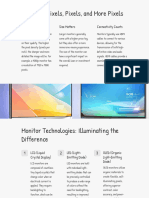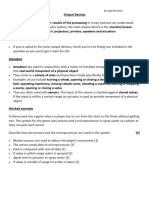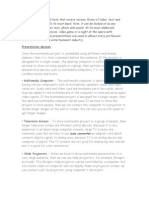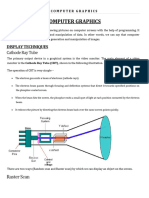0 ratings0% found this document useful (0 votes)
5 viewsOutput devices
The document provides an overview of various output devices, including DLP and LCD projectors, inkjet and laser printers, 3D printers, LED and LCD screens, loudspeakers, and actuators. Each device is described in terms of its functionality, advantages, and disadvantages, highlighting their applications and performance characteristics. Overall, the document emphasizes the diverse technologies available for visual and audio output, along with their specific use cases.
Uploaded by
bzg25f9d7nCopyright
© © All Rights Reserved
Available Formats
Download as DOCX, PDF, TXT or read online on Scribd
0 ratings0% found this document useful (0 votes)
5 viewsOutput devices
The document provides an overview of various output devices, including DLP and LCD projectors, inkjet and laser printers, 3D printers, LED and LCD screens, loudspeakers, and actuators. Each device is described in terms of its functionality, advantages, and disadvantages, highlighting their applications and performance characteristics. Overall, the document emphasizes the diverse technologies available for visual and audio output, along with their specific use cases.
Uploaded by
bzg25f9d7nCopyright
© © All Rights Reserved
Available Formats
Download as DOCX, PDF, TXT or read online on Scribd
You are on page 1/ 5
Output devices
Digital light processing (DLP) projector: DLP
stands for Digital Light Processing. DLP projectors
beam light through a color wheel, reflection mirrors,
then finally a lens. A DLP projector is excellent to use
in a home theater, on road trips, and on camping
outings. It displays stunning contrast levels and color
saturation, making it the ideal choice for dimly lit
areas. Works by reflecting light off microscopic
mirrored panels called Digital Micro-Mirror Devices
(DMD). Each DMD consists of millions of tiny mirrors,
each acting as a single reflective pixel in the
resolution of the projected image. They have a better
image representation, especially at higher
resolutions, higher brightness capabilities, better
predictability and stronger reliability. The main
drawback of a DPL projector is the "Rainbow Effect”.
This refers to the brief flashes of primary color that
are trailing the projected object (a moving ball, a
running car, etc.), potentially causing distraction and
discomfort during viewing.
Liquid crystal display (LCD) projector: An
LCD projector is a type of video projector for
displaying video, images or computer data on a
screen or other flat surface.L CD projectors provide
sharper images, better color accuracy, and brighter
outputs, making them suitable for well-lit spaces or
presentations. An LCD projector works with an optical
light engine, which incorporates three small LCD
panels, one for Red, Green and Blue paired with a
light source, various filters, mirrors and a prism to
create the image. LCD displays offer the advantage
of adjustable backlighting, reducing blue light
emission and potentially mitigating eye strain. LCD
displays offer the advantage of adjustable
backlighting, reducing blue light emission and
potentially mitigating eye strain.
Inkjet printer: Inject pronters produce hard copies
of a virtual document by spraying droplets of ink into
the paper. This type of printers are better for normal
day use in small offices or to keep at home.I n the
inkjet printing mechanism, the print head has several
tiny nozzles, also called jets. As the paper moves
past the print head, the nozzles spray the ink onto it,
forming the characters and images. Some
disadvantages of using inkjet printers is that a
constant paper refill is needed, as well as ink, the
quality of the prints depend on the quality of the
printer and the ink, which is different for each brand.
Inkjet printers are easy to use, they are fast and they
do not take up much space.
Laser printer: Laser printers read the electronic
data from your computer and beam this information
onto a drum inside the printer, which builds up a
pattern of static electricity, This attracts a dry
powder called toner onto the paper which is then
fused using heated rollers. laser printers use toner in
a powdered form, which contributes to fewer
clogging issues and faster printing speeds, making
them ideal for text-heavy documents.
3D printer: 3D printers are ideal to create replicas
or to bring ideas to life from a vistual design. It works
by exposing a layer of photosensitive liquid resin to a
UV-laser beam; the resin then hardens in the desired
pattern, and the object is built layer by layer until it
is complete. Objects printed by SLA 3D printers have
smooth surfaces, but often the quality depends upon
the printer type. An advantage of using 3D printers in
that they can use different types of materials,
inclusind recycled ones, on the other hand, they are
expensive and really slow.
Light emitting diode (LED) screen: electronic
devices made of tiny light bulbs that work together
by emitting light when an electric current is passed
through them to create images or text. This tiny light
bulbs come in three colours, green, red, and blue. An
electrical current passes through a microchip, which
illuminates the tiny light sources we call LEDs and
the result is visible light. LEDs require less power to
produce the same level of brightness. They have a
great quality and durability, they are ideal for
videogaming, but they are also really expensive and
have a high mantainance cost.
Liquid crystal display (LCD) screen: LCDs are
lit by a backlight, and pixels are switched on and off
electronically while using liquid crystals to rotate
polarized light. A polarizing glass filter is placed in
front and behind all the pixels, the front filter is
placed at 90 degrees. Light passes through the liquid
crystals and color filters to create the image you see
on LCD screens. LCD screens don’t take up much
energy, they are durable, they are cheap, they have
a high resolution and they have a great color
accurancy.
Loud Speaker: Speakers are used to amplify
sound. A speaker is a device that converts electrical
signals into sound waves. It allows you to hear audio
output from various devices such as computers,
smartphones, televisions, and music players.
Speakers work by converting electrical energy into
mechanical energy (motion). The mechanical energy
compresses air and converts the motion into sound
energy or sound pressure level (SPL).
Actuator: An actuator is a part of a device or
machine that helps it to achieve physical movements
by converting energy, often electrical, air, or
hydraulic, into mechanical force. Simply put, it is the
component in any machine that enables movement.
In engineering, actuators are frequently used as
mechanisms to introduce motion, or to clamp an
object so as to prevent motion. In electronic
engineering, actuators are a subdivision of
transducers. They are devices which transform an
input signal (mainly an electrical signal) into some
form of motion. Electric actuators provide extremely
accurate control and positioning. In addition, this
type of actuator helps adapt machines to flexible
processes and has a low operating cost. This means
that an electric system is energy efficient and can
provide you with cost savings in many cases.
You might also like
- CRT Monitor LCD Monitor LED Monitor Plasma MonitorNo ratings yetCRT Monitor LCD Monitor LED Monitor Plasma Monitor7 pages
- 3.4 Output Devices: Printers: Inkjet Printers ActuatorsNo ratings yet3.4 Output Devices: Printers: Inkjet Printers Actuators4 pages
- Projectors 150119151058 Conversion Gate02 PDFNo ratings yetProjectors 150119151058 Conversion Gate02 PDF13 pages
- Output Technologies: Muhammad Salim Sunil Kumar Gupta Praveen KumarNo ratings yetOutput Technologies: Muhammad Salim Sunil Kumar Gupta Praveen Kumar26 pages
- Basic Computer Graphic Devices: Display DeviceNo ratings yetBasic Computer Graphic Devices: Display Device11 pages
- Digital Light Processing: Brings A Revolution!No ratings yetDigital Light Processing: Brings A Revolution!6 pages
- Selecting Video Monitors For The Home Features Of The Best Video MonitorFrom EverandSelecting Video Monitors For The Home Features Of The Best Video MonitorNo ratings yet
- Distance Fog: Exploring the Visual Frontier: Insights into Computer Vision's Distance FogFrom EverandDistance Fog: Exploring the Visual Frontier: Insights into Computer Vision's Distance FogNo ratings yet
- Global Illumination: Advancing Vision: Insights into Global IlluminationFrom EverandGlobal Illumination: Advancing Vision: Insights into Global IlluminationNo ratings yet
- Z@@Shenkar2022 Article TheLastFrontierOfGlobalizationNo ratings yetZ@@Shenkar2022 Article TheLastFrontierOfGlobalization13 pages
- Lexber Inc. V Sps. Dalman G.R. No. 183587, April 20, 2015No ratings yetLexber Inc. V Sps. Dalman G.R. No. 183587, April 20, 201514 pages
- Worksheet 26 Pronouns and Their AntecedentsNo ratings yetWorksheet 26 Pronouns and Their Antecedents2 pages
- Leading the Way in Financial Excellence: M&M AL MENHALI AUDITING, Dubai's Top Accounting FirmNo ratings yetLeading the Way in Financial Excellence: M&M AL MENHALI AUDITING, Dubai's Top Accounting Firm7 pages
- En Collection of Data Sheets MPS PA 090804No ratings yetEn Collection of Data Sheets MPS PA 090804194 pages
- Atashi No Onii-Chan Dekita! Onii-Chan7313No ratings yetAtashi No Onii-Chan Dekita! Onii-Chan73131 page
- Ramchandra Dwivedi Rachnavali - Edited by Surya Prakash Vyas100% (1)Ramchandra Dwivedi Rachnavali - Edited by Surya Prakash Vyas255 pages
- IT Project Management 2023-2024_Final AssignmentNo ratings yetIT Project Management 2023-2024_Final Assignment4 pages
- Dying A Social Perspective On The End of Life Alex Broom Download PDF100% (8)Dying A Social Perspective On The End of Life Alex Broom Download PDF65 pages
- Practice Questions - Aggregate Supply Andn Demand - Answer KeyNo ratings yetPractice Questions - Aggregate Supply Andn Demand - Answer Key5 pages
- CRT Monitor LCD Monitor LED Monitor Plasma MonitorCRT Monitor LCD Monitor LED Monitor Plasma Monitor
- 3.4 Output Devices: Printers: Inkjet Printers Actuators3.4 Output Devices: Printers: Inkjet Printers Actuators
- Output Technologies: Muhammad Salim Sunil Kumar Gupta Praveen KumarOutput Technologies: Muhammad Salim Sunil Kumar Gupta Praveen Kumar
- Selecting Video Monitors For The Home Features Of The Best Video MonitorFrom EverandSelecting Video Monitors For The Home Features Of The Best Video Monitor
- Distance Fog: Exploring the Visual Frontier: Insights into Computer Vision's Distance FogFrom EverandDistance Fog: Exploring the Visual Frontier: Insights into Computer Vision's Distance Fog
- Global Illumination: Advancing Vision: Insights into Global IlluminationFrom EverandGlobal Illumination: Advancing Vision: Insights into Global Illumination
- Z@@Shenkar2022 Article TheLastFrontierOfGlobalizationZ@@Shenkar2022 Article TheLastFrontierOfGlobalization
- Lexber Inc. V Sps. Dalman G.R. No. 183587, April 20, 2015Lexber Inc. V Sps. Dalman G.R. No. 183587, April 20, 2015
- Leading the Way in Financial Excellence: M&M AL MENHALI AUDITING, Dubai's Top Accounting FirmLeading the Way in Financial Excellence: M&M AL MENHALI AUDITING, Dubai's Top Accounting Firm
- Ramchandra Dwivedi Rachnavali - Edited by Surya Prakash VyasRamchandra Dwivedi Rachnavali - Edited by Surya Prakash Vyas
- Dying A Social Perspective On The End of Life Alex Broom Download PDFDying A Social Perspective On The End of Life Alex Broom Download PDF
- Practice Questions - Aggregate Supply Andn Demand - Answer KeyPractice Questions - Aggregate Supply Andn Demand - Answer Key

























































































